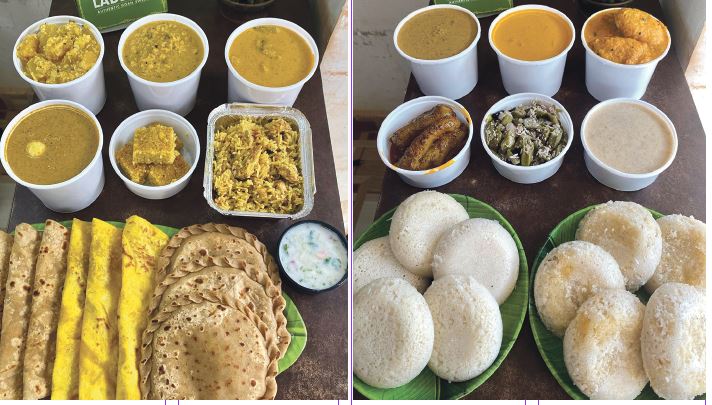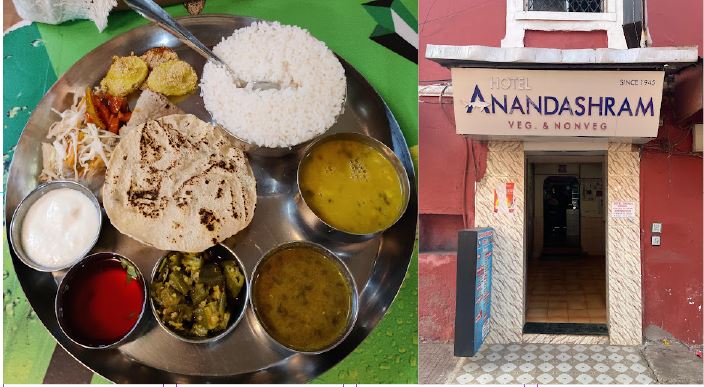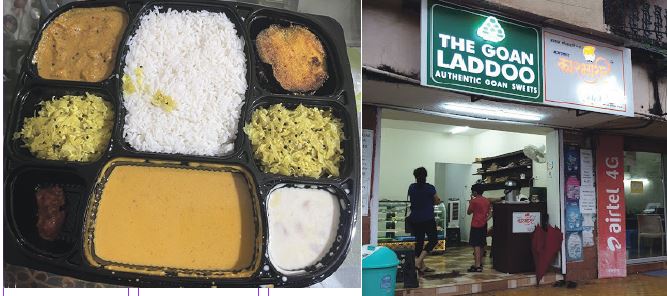An honest, low-cost khanaval near your home is a heaven-sent blessing…and can never fail businesswise.
A NEED FOR MORE KHANAVAL’S! The Amey and Priya Vaingankar’s “Goan Ladoo” comes very close to being a traditional khanaval retailing traditional food one may pick as a mini or full meal deal, or as per what’s on the daily menu. It started off as a ladoo only place (I love the besan ladoo) and did so well it decided to branch out into freshly prepared food as in the much loved dishes of Goan Hindu cuisine. Khanaval’s are usually lunch-time humble places where the working class may find a home-cooked veg or non-veg meals at decent price (currently from Rs80 to Rs100 plus, plus. In Mumbai there’re several renowned khanaval’s run by women’s co-operatives and their food is much in demand by office-goers who commute long distances. In Goa there must be quite a few khanaval’s too but we have to find them!
AS I paid Rs10 for a medium-sized carrot this morning I knew the price of food has gone up once again, too soon! The vendor at the early morning pavement market at Panjim muttered “mahad, mahad bai!” She can’t help it, food has become expensive and she has to hike the prices of her vegetables by Rs10 if need be – these days there’s no rhyme or reason when hiking rates. It can be arbitrary or just a personal whim.
A slender medium-sized dudhi or bottle gourd was only Rs20 or Rs25 till very recently is now Rs50; almost every veggie begins with Rs50 although I may get a bunch of dill greens which I love so much for Rs30 sometimes if I am lucky. The price of tender coconut water is now Rs50…five cucumbers Rs50, five of the monsoon season’s luscious fat green ambade or hog plums — Rs50. A single drumstick? Rs10. Eggs? Anything from Rs80 to Rs85 dozen. A lot of sighs around if you’re aam aurat!
I tell myself the next time I see a drumstick tree near where I stay and it’s loaded with drumsticks, I will just help myself if nobody stops me and if someone hasn’t got there first. The old world housing complex where I live in Caranzalem has a lot of curry leaf bushes, any number of papaya trees and banana palms, and a gorgeous lemon tree. The hardworking Nepali team which runs the place either harvests and distributes these “orchard” freebies to the ownership of resident flats or make the most of leftovers for their own migrant families.
Most flat owners or rather most Goan owners are in London or USA or Portugal or moved to newer more organized premises in Goa itself, keep their flats locked while awaiting a buyer or lease them out as lucrative B&B rentals to casino staff from outside Goa. After more or less two years of indifference, I have planted tulsi and some Malabar spinach at my own rental doorstep, on a patch of soil… and it flourishes.
Sometimes my Malabar spinach greens are filched I don’t know what I’m waiting for before I turn the spinach into a raita or a soup! Greens make wonderful curd raita, just chop, blanch and mix in curd, flavour with Himalaya pink or black “sanchar” or sea salt (it’s our version of Celtic salt or so I like to think).
Once I got a couple of maroon sweet maroon red sweet potato twists (the little knobs of sweet potato are hard to find) and I steam-cooked them, chunked them, sprinkled red Himalayan salt crystals on them and voila…yummilicious, a real feast! Better than refined white rice, fryum puri, better than anything. I can make a meal of such sweet potatoes to say the least here. Goans do turn them into shallow fryum “kappam” as with neerponos or breadfruit or any of the popular root tubers. Extra something savoury for a meal, salt and turmeric smeared, rava-fried kappam! I like the shallow fryum kappam more than the deep fried fryums as a rule.
ONCE in a way I get tired of going to the iconic restaurants and Goan eateries to pick up a meal which will add up to Rs500 plus, plus. It makes more sense in Panjim to find a decent homely “khanaval” (traditional lunch home) to see what the day’s menu is and buy home something on an ad hoc basis. Since prices have been spiralling out of aam aadmi budgets I feel there’s a great need for more of these humble “khanaval” outlets where one may sit and eat a thali meal deal of freshly prepared food (the upper crust restaurants and eateries don’t give you absolutely freshly prepared food, it’s partially pre-cooked or out of bottles, tins or semi-prepared and stocked in the fridge for later heating up and seasoning and tempering before retailing at table at absurd pricing).

But at a humble khanaval like say the flourishing and overcrowded nearing lunchtime Goan Ladoo at St Inez — one may pack home a “mooga gaati” portion for Rs80 or a plate of “nirpanas kappa” slices (Rs100 for four or five pieces), or puranpoli (sweet chappaties, Rs25 each)…what I love is the tangy ambade sasav (hog plum relish, also pineapple sasav) and soft rice and urid dal batter polle, thick soft pancake-styled local pancakes but far superior to the thin Continental pancakes of refined flour-sugar-egg-butter laced with honey, maple syrup or some wretched cloyingly sweet sugar syrup, utterly yuk!).
The Goan Ladoo khanaval outlet started off a few years ago with an array of wholesome ladoo, a much loved national sweet in various infinite avatar. It now offers meal deals for Rs130 to Rs160, plus, plus – a thick chapatti, generous portion of rice, sabzi dry and with gravy (for example, tamdi bhaji greens done in usual Goan style, steam cooked in terracotta pot and laced with freshly grated, sometimes fresh white radish slices added in for divine flavor), then there’s the gravy rich mushroom xacuti or chana usal or chavli ros…to complete the meal a portion of a sweet “shevyo kheer” or “mangane.” Not to forget the itsy bitsy teaspoon of tart fresh mango pickle. Menu changes daily and prices re-arrange themselves depending on the cost of making the dish.
One may take the full meal deal packed in pocket plastic trays or just buy whatever item number one desires for Rs60-Rs80 per portion, I usually look for my favorite “mooga ghaati” or “ambade sasav” or “khatkate” or “mushroom xacuti.” They also do puranpoli (Rs25 each). By all means take your own dibba if you don’t want to bring home food in vile plastics, I usually do.
When you have no time to cook at home from scratch in a family of two growing old and older as in couple, it’s cost-effective to buy from a local khanaval outlet and I wish there were more of them! More khanaval please, believe me, they’re doing better than most of the hi fi new fancy pizza outlets which open for a few months and a year later shut down.
A traditional khanaval is where one may just go and eat or buy from the daily freshly prepared menu of local dishes. It’s more economical than buying home from the upper crust or less upper crust eateries and iconic restaurants of old or new vintage. But there’re very few khanaval outlets in Panjim and some of them just like to be just seafood and fish thali places like say Anandashram on 31st January road.
There’re something like 406 restaurants famous and not so famous in Panjim and many specialize in fish thali meal deals from Rs80 to Rs150 to plus, plus. The Goan manoos loves his fish curry even during the monsoon months although some also offer vegetarian meal deals during the monsoon Chaturmaas months –they’re a real boon for aam aadmi.

I welcome all khanaval outlets although I don’t think Goan food as health-conscious and it’s becoming too spicy for me; I prefer to stick to the veggies done simply in terracotta ware at some outlets. I get a dry sabzi or gravy sabzi dish to go with my millet “rice” which I prepare at home. Local khanaval food is usually prepared by members of a large family or a neighborly co-operative of women and some of them work very well in the interests of low and middle income folk and working classes.
In Mumbai I remember several kutumb sakhi or women’s co-operatives running khanaval outlets (think junka-bhakar as in large jowari, that is sorghum millet, or bajra, that is pearl millet, bhakri that is thickish chapatti, accompanied with aromatic savoury thick or thin junka of gram flour, protein rich offering garnished with lots of freshly chopped green coriander; and the most desirable “sing ladu” (peanut sweet ball). All at decent aam aadmi or aam aurat prices, one may have a meal deal for Rs25 or Rs50. Such khanaval outlets are very popular of course and come with long queues in the business districts of down town Mumbai, some khanaval operate out of mobile vans.
A LONG, long time ago when I was visiting my old home town of Penang in Malaysia my friend Lalita Sinha invited me to her University of Penang for lunch and I was surprised to see this spread of containers of various kinds of food at the canteen – from various kinds of rice (plain, egg-fried, Chinese fry, etc) to veggies dry and saucy, and amazing assorted salads, local desserts of scrumptious kueh kueh (mostly steam cooked sweet something – all freshly prepared food.
One simply helped oneself by the portion spoon and took one’s tray it to the cashier who billed up – either sit and eat here at the canteen or pack home. Yes, a south-east Asian “khanaval” spread offering a large selection of freshly made health-conscious food, a dream come true for folk with limited income. (Sigh) Nobody is doing such a “khanaval” in Panaji yet, where one may just go and look at the containers full of freshly prepared food and take one’s pick and pack home at aam aadmi-friendly rates! It’s actually a friendlier way to retail food.
Khanaval is an idea whose time has come in our troubled and hassled times where the government of the day has a GST whip in its anti-aam aadmi budget, read the latest budget just announced by Finance Minister Nirmala Seetharam …people don’t pay income tax so now we’re a monster GST- driven economy so that the government may built more highways, bullet trains and temples to Lord Ram. Better build a temple to Lord Ravan now!
MY FRIEND Jaya at a place I’ve a soft corner for, Bassera down-town Panjim (near the Kala Academy), shares that they’re “doing almost 80% takeaways!” Their menu has some Sindhi favorites such as “tuk tuk” and Sindhi curry and these days they’re putting out some innovative puddings. Like I said the Swiggy and Zomato guys come and go for business is mostly on phone, few like to go out to sit and eat except on celebration occasions.
THERE are of course any number of places doing fish thali in Panaji! But come the monsoon months folk look for vegetarian meals, especially since the monsoon market is packed with sumptuous local Konkan greens like “akoor” or “ankoor” and large heart-shaped taro or arbi leaves, dill greens are my favorite, drumstick greens, mustard greens, red and green chaulai (amaranth) or the sour ambade greens – of course lots of white or daikon radish greens which can liven up say a red amaranth or tamdi bhaji most flavorfully – this simple greens bhaji cooks in a pot in their own juices, finally seasoned with salt, slit green chillies and freshly grated coconut, truly agreeable.
Greens are mostly done like this and tempered or not tempered in bit coconut oil. I prefer un-tempered. Tempering is a very north Indian thing we do so obsessively, it’s really unwarranted especially when the refined oils come with a terrible health brief. Small quantity coconut oil or olive oil is best although I also like manually or cold pressed rice bran oil, but I use it mostly for making my evening diya. Rice bran oil has a high burning point and my diya burns all night long till dawn.
